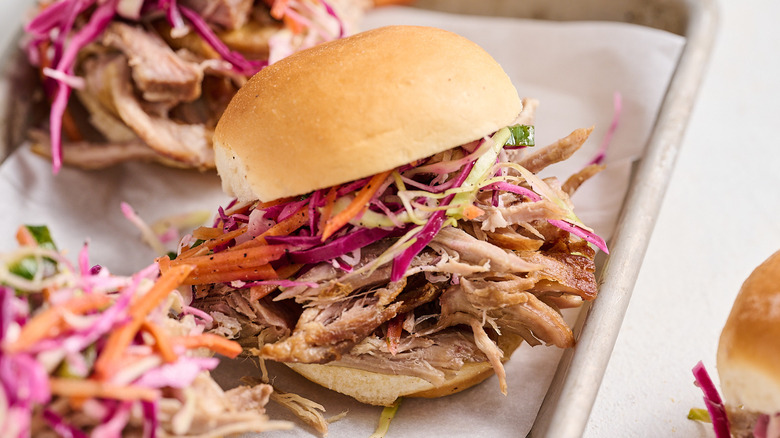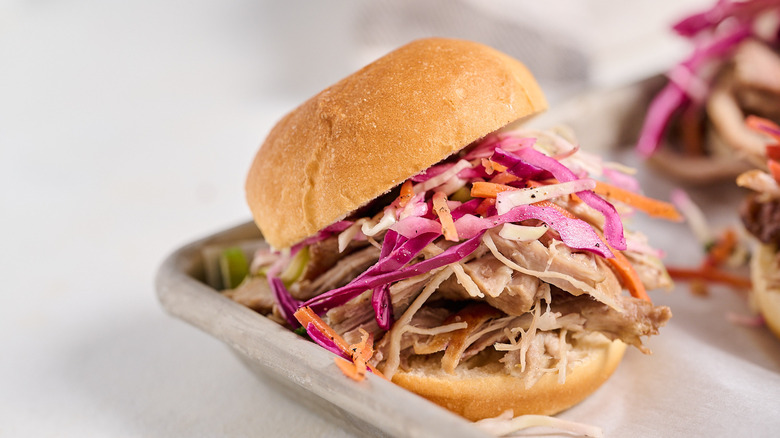Hawaiian Pulled Pork Sandwiches Recipe
One of Hawaii's most famous dishes is pork — or rather, pig. Kalua pork is a type of pulled pork served at luaus alongside rice and cabbage. "Kalua" means "to cook in an underground oven," which helps describe how the pork is made. Similar to Mexican barbacoa, kalua pork is cooked underground in a pit made for slow-roasting. A whole pig is wrapped in leaves and lowered into the wood and stone oven, called an imu, to roast until moist and pull-apart tender, not to mention imbued with smoky flavor.
While we would love to make and use our own imu, many of us don't even have a backyard, let alone the time to dig an enormous pit. Instead, braising is a good home-cook solution that can offer similar results. A simple pork shoulder, liquid smoke, some pineapple juice, and a few banana leaves can help replicate the smoky-sweet flavor of Kalua pork right in your own oven. Though it won't be exactly the same, it's as close as you can get without an actual imu. Paired with a tangy cabbage coleslaw, this Hawaiian pork recipe by Michelle McGlinn brings the taste of a luau between two buns.
The ingredients needed for Hawaiian pulled pork sandwiches
The first thing you'll need for this recipe is a pork shoulder. Often sold as halves, you'll just need 3-4 pounds for the sandwiches, with or without the bone. From there, you'll need garlic cloves, olive oil, liquid smoke, soy sauce, pineapple juice, chicken broth, Hawaiian alaea salt, and banana leaves. Look for banana leaves in the frozen aisle of Latin American or Asian markets, where they are used for traditional dishes like lontong and cochinita pibil. For the slaw, grab green and red cabbages, shredded carrots, chopped green onion, apple cider vinegar, sugar, salt, and black pepper. Then, to finish the sandwiches, you'll just need buns — of course, we suggest Hawaiian rolls.
Step 1: Heat up the oven
Preheat the oven to 320 F.
Step 2: Stick garlic cloves into the pork shoulder
Slice 12 small slits all over the pork shoulder and insert a garlic clove into each opening.
Step 3: Oil a Dutch oven
Add olive oil to a Dutch oven and place over medium heat.
Step 4: Sear the pork
Once hot, add the pork and sear on all sides until golden brown, about 10 minutes. Transfer to a plate and set aside.
Step 5: Arrange the banana leaves in the pot
Remove the Dutch oven from the heat. Arrange the banana leaves in the pot so the leaves overlap in the center.
Step 6: Add the pork and seasonings
Place the pork in the center of the leaves. Pour over the liquid smoke, soy sauce, and pineapple juice and season with sea salt, working the ingredients into the pork with your hands as needed.
Step 7: Wrap the leaves around the pork
Wrap the banana leaves over the pork, encasing the meat completely.
Step 8: Pour in the broth and cover the pot
Pour the broth over the leaves, and cover the pot.
Step 9: Braise the pork until tender
Place the pork into the oven to braise for 2 ½-3 hours, or until pull-apart tender.
Step 10: Make the coleslaw
Meanwhile, place the cabbages, carrot, green onion, vinegar, water, sugar, salt, and pepper into a large bowl. Add 2 tablespoons water, toss to combine, and set aside.
Step 11: Shred the pork
Once cooled, pull the pork apart using two forks.
Step 12: Assemble and serve the sandwiches
Fill the Hawaiian rolls with pulled pork and the prepared coleslaw, and serve.
What is Hawaiian alaea salt?
A key ingredient in Kalua pork is the salt. While you can certainly use one of many different types of salt — like kosher, Himalayan, or sea salt — without issue, there's an added benefit to using Hawaiian red salt, otherwise known as alaea salt. This salt gets its brick red color from volcanic alaea clay, which is rich in minerals. It's similar in coarseness to Himalayan pink salt but much deeper in color. Unlike many salts, alaea salt has a milder flavor, tasting less sharp and more earthy. It's perfect for traditional Kalua pork because it complements the sweet banana leaves while emphasizing the smoky earthiness from the imu cooking method.
You may need to visit specialty stores that sell a variety of salts to find alaea salt, such as spice-specific stores or grocers specializing in Pacific cuisine. If you can't find alaea salt, you can swap it for kosher or sea salt, but you'll want to adjust the amount. For fine-grained kosher, use about half the salt. For coarse sea salt, use about ¾.
Why is Hawaiian pork cooked with banana leaves?
A few famous meat dishes from around the world are cooked in large leaves: Mexican barbacoa, Yucatán cochinita pibil, and of course, Hawaiian kalua. Often, these leafy cooking methods are rustic and done outdoors, as is the case with the imu used for kalua pig. The large leaves first serve as a way to protect the meat from dirt, grass, and debris. But more importantly, they steam the pork, infusing it with the mild flavor of the leaves while holding in the meat's moisture.
Banana leaves are easy to find in most Hawaiian, Latin American, or Asian stores, but traditionally the pork can also be wrapped in ti plant leaves or wet burlap sacks. Though you can certainly use either of those to make your kalua pork, we recommend seeking out the food-safe, ready-to-use banana leaves, which are usually sold frozen in grocery stores. And if you can't find leaves at all? Just skip it: The pork will be just as good, and as long as you braise the meat to juicy perfection, the flavor differences will be subtle.

- 1 (3-4 pound) pork shoulder
- 6 cloves garlic, peeled and halved
- 2 tablespoons olive oil
- 4 banana leaves
- 1 tablespoon liquid smoke
- 1 teaspoon soy sauce
- ¼ cup pineapple juice
- 1 teaspoon Hawaiian alaea sea salt
- 2 cups chicken broth
- 1 cup shredded green cabbage
- 1 cup shredded red cabbage
- ½ cup shredded carrot
- ¼ cup chopped green onion
- ¼ cup apple cider vinegar
- 2 tablespoons sugar
- 1 teaspoon salt
- ½ teaspoon black pepper
- 12 Hawaiian rolls
- Preheat the oven to 320 F.
- Slice 12 small slits all over the pork shoulder and insert a garlic clove into each opening.
- Add olive oil to a Dutch oven and place over medium heat.
- Once hot, add the pork and sear on all sides until golden brown, about 10 minutes. Transfer to a plate and set aside.
- Remove the Dutch oven from the heat. Arrange the banana leaves in the pot so the leaves overlap in the center.
- Place the pork in the center of the leaves. Pour over the liquid smoke, soy sauce, and pineapple juice and season with sea salt, working the ingredients into the pork with your hands as needed.
- Wrap the banana leaves over the pork, encasing the meat completely.
- Pour the broth over the leaves, and cover the pot.
- Place the pork into the oven to braise for 2 ½-3 hours, or until pull-apart tender.
- Meanwhile, place the cabbages, carrot, green onion, vinegar, water, sugar, salt, and pepper into a large bowl. Add 2 tablespoons water, toss to combine, and set aside.
- Once cooled, pull the pork apart using two forks.
- Fill the Hawaiian rolls with pulled pork and the prepared coleslaw, and serve.
| Calories per Serving | 1,471 |
| Total Fat | 69.7 g |
| Saturated Fat | 21.1 g |
| Trans Fat | 0.0 g |
| Cholesterol | 214.9 mg |
| Total Carbohydrates | 135.1 g |
| Dietary Fiber | 8.6 g |
| Total Sugars | 29.0 g |
| Sodium | 2,124.4 mg |
| Protein | 73.6 g |
















